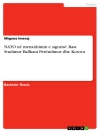Cuprins
Frontmatter – CONTENTS – INTRODUCTION – CONTRIBUTORS TO THIS VOLUME – I. ISSUES – 1. The Soviet Union: Her Aims, Problems, and Challenges to the West – 2. The Stalinist Legacy in Soviet Foreign Policy – 3. The Nature of Soviet Power – 4. The New Dynamics of the Soviet Empire: From Optimism to Pessimism – 5. Soviet Domestic Politics and Foreign Policy – 6. What Do Scholars Know about Soviet Foreign Policy? – 7. Soviet Ideology, Risk-Taking, and Crisis Behavior – II. POLICYMAKING AND IMPLEMENTATION – 8. Anatomy of Policymaking – 9. Soviet Perspectives on ‘The Scientific-Technological Revolution’ and International Politics – 10. The Foreign Policy Establishment – 11. Decision Making for Arms Limitation in the Soviet Union – 12. The CPSU Central Committee’s International Department – 13. ‘Active Measures’ in Soviet Strategy – III. MILITARY POWER – 14. Soviet Perspectives on Security – 15. Military Power and Political Purpose in Soviet Policy – 16. The Satisfaction of Operational Objectives – 17. Soviet Strategy toward Northern Europe and Japan – 18. The Soviet-Afghan War: The First Four Years – IV. THE UNITED STATES – 19. The United States and the Soviet Union, 1917-1976 – 20. The Sources of American Conduct: Soviet Perspectives and Their Policy Implications – 21. The Soviet Union and Strategic Arms – 22. Selling the Russians the Rope? Soviet Technology Policy and U.S. Export Controls – 23. U.S. and Soviet Agriculture: The Shifting Balance of Power – 24. The New Soviet Challenge and America’s New Edge – V. WESTERN EUROPE – 25. The USSR and Western Europe – 26. Soviet Nuclear Weapons in Europe – 27. Soviet Economic Policies in Western Europe – 28. Capitalist Contradictions and Soviet Policy – VI. EASTERN EUROPE – 29. Soviet Policy toward Eastern Europe: Interests, Instruments, and Trends – 30. The Soviet Union and the East European Militaries: The Diminishing Asset – 31. The Political Economy of Soviet Relations with Eastern Europe – 32. Soviet Empire: Alive but Not Well – VII. THE FAR EAST – 33. Asia in the Soviet Conception – 34. Siberian Development: The Strategic Implications – 35. Soviet Policy toward China – 36. The Moscow-Beijing Détente – VIII. THE THIRD WORLD – 37. Soviet Geopolitical Momentum: Myth or Menace? Center for Defense Information – 38. Soviet Arms Trade with the Noncommunist Third World – 39. The USSR and the Third World: Economic Dilemmas – 40. The Correlation of Forces and Soviet Policy in the Middle East – 41. The Soviet Union and the Peace Process since Camp David – 42. Soviet Options and Opportunities in Southern Asia – 43. New Trends in Soviet Policy toward Africa – 44. The Soviets and Latin America: A Three Decade U.S. Policy Tangle – IX. THE FUTURE – 45. Can the Soviet Union Reform? – 46. The Changing Soviet Union and the World – 47. Socialist Stagnation and Communist Encirclement – 48. Soviet Global Power and the Correlation of Forces – 49. KAL 007: Perceptions and Politics – 50. What the Russians Really Want: A Rational Response to the Soviet Challenge – 51. The Future of Yalta – 52. Managing the U.S.-Soviet Relationship over the Long Term












